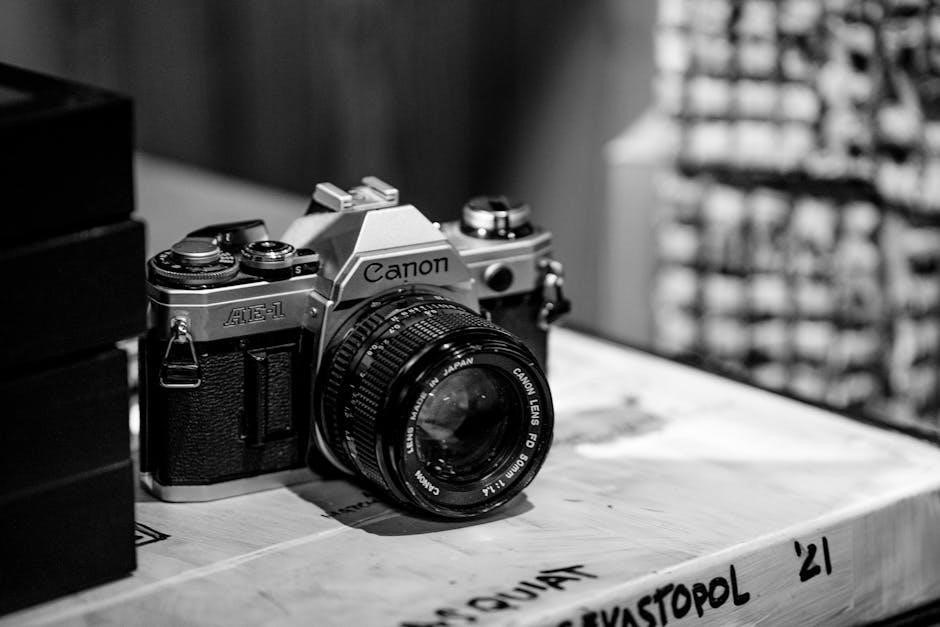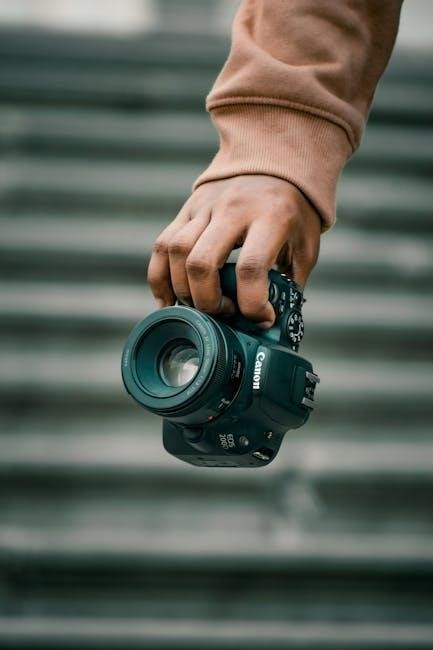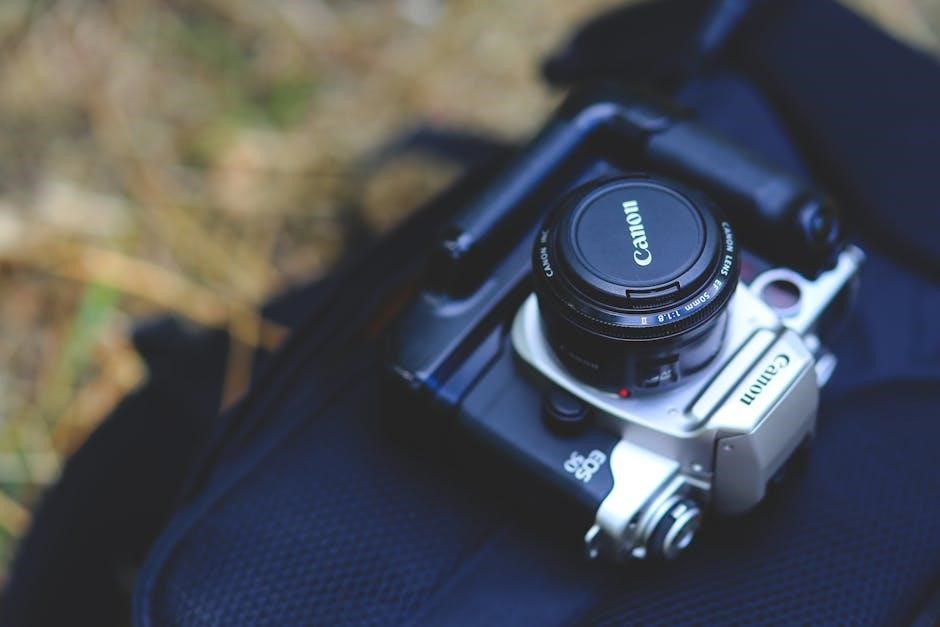The Canon EOS 70D is a high-performance DSLR camera designed for enthusiasts and professionals․ It features a 20․2MP APS-C CMOS sensor, delivering exceptional image quality and responsiveness․
1․1 Overview of the EOS 70D Camera
The Canon EOS 70D is a versatile DSLR camera designed for both enthusiasts and professionals․ It boasts a 20․2-megapixel APS-C CMOS sensor, offering excellent image quality and sensitivity․ The camera features Dual Pixel CMOS AF, enabling fast and precise autofocus during live view and video recording; With a vari-angle 3-inch touchscreen LCD, it provides flexible shooting angles and intuitive control․ The EOS 70D also includes built-in Wi-Fi for easy image sharing and remote shooting via a smartphone․ Its robust build and ergonomic design make it suitable for various photography scenarios, from portraits to action shots․ The camera supports continuous shooting up to 7 fps, ensuring capture of dynamic moments with ease․
1․2 Key Features and Capabilities
The Canon EOS 70D stands out with its advanced feature set, catering to both stills and video shooters․ It offers a robust 20․2MP APS-C CMOS sensor, Dual Pixel CMOS AF for smooth autofocus, and a DIGIC 5+ image processor for enhanced performance․ The camera supports ISO ranges from 100 to 12800, expandable to 25600, ensuring low-light versatility․ Its 7 fps continuous shooting mode captures dynamic action effortlessly․ The vari-angle 3-inch Clear View II LCD touchscreen enhances compositional flexibility․ Built-in Wi-Fi enables wireless image transfer and remote camera control․ Additionally, the EOS 70D supports Full HD 1080p video recording at 30 fps, making it a capable tool for videographers․ These features combine to deliver a powerful, adaptable imaging solution for diverse creative needs․

Shooting Modes and Settings
The Canon EOS 70D offers a variety of shooting modes and settings, accessed via the mode dial, including automatic, creative, and special scene modes for diverse photography needs, ensuring flexibility and creativity․
2․1 Understanding the Mode Dial
The EOS 70D’s mode dial provides quick access to shooting modes․ It includes automatic settings like Scene Intelligent Auto and Creative Auto for simplicity․ For more control, modes such as Program AE (P), Shutter Priority AE (Tv), Aperture Priority AE (Av), and Manual (M) are available․ Additionally, the dial features Special Scene modes like Portrait, Landscape, Close-up, Sports, and Night Portrait, each optimized for specific shooting conditions․ The mode dial’s intuitive design allows users to easily switch between settings, catering to both beginners and advanced photographers seeking flexibility and precision in their work․ This versatility ensures optimal results across various photography scenarios․
2․2 Creative Modes (P, Av, Tv, M)
The EOS 70D offers four creative modes: Program AE (P), Aperture Priority AE (Av), Shutter Priority AE (Tv), and Manual (M)․ Program AE balances aperture and shutter speed automatically but allows adjustments․ Aperture Priority (Av) lets you set the aperture to control depth of field, ideal for portraits or landscapes․ Shutter Priority (Tv) enables manual shutter speed adjustment, perfect for freezing or blurring motion․ Manual (M) mode grants full control over both aperture and shutter speed, offering ultimate creativity․ These modes cater to photographers seeking flexibility and precision, allowing for tailored adjustments to achieve desired effects in various shooting scenarios․
2․3 Special Scene Modes
The Canon EOS 70D features a variety of Special Scene modes tailored for specific shooting conditions․ These include Portrait, Landscape, Close-up, Sports, and Night Portrait modes․ Each mode automatically adjusts camera settings to optimize results in their respective scenarios․ Portrait mode softens backgrounds to emphasize subjects, while Landscape mode ensures sharpness across the frame․ Close-up mode enhances detail in small subjects, and Sports mode prioritizes fast shutter speeds for capturing action․ Night Portrait mode balances subject and background lighting for low-light portraits․ These modes simplify photography, allowing users to achieve professional-looking results without manual adjustments, making them ideal for photographers of all skill levels․

Autofocus and Metering
The EOS 70D features advanced autofocus and metering systems for precise control․ Its 19-point AF system ensures sharp focus, while metering modes like Evaluative, Center-Weighted, and Spot deliver accurate exposures;
3․1 AF Point Selection and Tracking
The Canon EOS 70D offers versatile AF point selection and tracking options․ Users can manually select from 19 cross-type AF points for precise focus control․ The camera also features advanced tracking capabilities, allowing continuous focus on moving subjects․ This is particularly useful in sports and wildlife photography․ Additionally, the EOS 70D supports Zone AF, which groups AF points for enhanced subject tracking․ The camera’s AI Servo AF mode predicts subject movement, ensuring sharp images even with fast-paced action․ These features make the EOS 70D a reliable choice for capturing dynamic moments with ease and accuracy․
3․2 Metering Modes (Evaluative, Center-Weighted, Spot)
The Canon EOS 70D features three metering modes: Evaluative, Center-Weighted, and Spot․ Evaluative metering analyzes the entire scene to balance exposure across brightness and shadows․ Center-Weighted prioritizes the central area, ideal for portraits․ Spot metering measures a small, specific area, useful for high-contrast scenes․ These modes ensure accurate exposure calculation, enhancing image quality in various lighting conditions․ The camera’s advanced metering system adapts to the scene, providing reliable results for both beginners and professionals․ This versatility makes the EOS 70D a powerful tool for capturing images with precision and control․

ISO and White Balance
The Canon EOS 70D offers an ISO range of 100-12800, expandable to 25600, with noise reduction options․ White Balance includes Auto, Daylight, Shade, Tungsten, and custom presets․
4․1 ISO Sensitivity and Noise Reduction
The Canon EOS 70D offers an ISO range of 100 to 12,800, expandable to 25,600 for low-light conditions․ The camera features advanced noise reduction technology to minimize grain and ensure sharp images․ shooters can enable noise reduction settings to optimize image quality, especially at higher ISOs․ This ensures that photos remain clear and detailed even in challenging lighting environments, making the EOS 70D versatile for various photography needs․ Additionally, the noise reduction can be adjusted to suit personal preferences, allowing for a balance between detail retention and noise suppression․
4․2 White Balance Settings and Custom Options
The Canon EOS 70D offers a range of white balance settings to ensure accurate color reproduction in various lighting conditions․ Preset options include Auto, Daylight, Shade, Tungsten, Fluorescent, and Flash․ For precise control, the camera allows custom white balance settings, enabling users to capture a reference object and set it as the white point․ Additionally, the EOS 70D supports color temperature adjustment in Kelvin (2500K–10,000K), providing flexibility for creative or specific lighting scenarios․ These advanced options enable photographers to achieve professional-grade color accuracy and consistency in their images, making the EOS 70D a versatile tool for diverse photography needs․

Image Quality and Formats
The Canon EOS 70D supports RAW, JPEG, and HEIF formats, ensuring flexibility in image quality; RAW captures maximum detail, while JPEG offers compressed, shareable files․
5․1 RAW vs․ JPEG vs; HEIF Formats
The Canon EOS 70D offers three primary image formats: RAW, JPEG, and HEIF․ RAW files capture maximum image data, ideal for post-processing and retaining detail․ JPEG files are compressed, smaller in size, and suitable for sharing․ HEIF (High Efficiency Image Format) provides better compression than JPEG without sacrificing quality․ RAW is best for professionals needing flexibility, while JPEG and HEIF are convenient for everyday use․ The camera allows simultaneous recording of RAW and JPEG, enabling quick access to both formats․ HEIF is supported for efficient storage and sharing, making it a versatile option for modern photographers․ Each format caters to different needs, ensuring optimal image quality and workflow efficiency․
Movie Recording and Video Features
The EOS 70D supports full HD video recording at 1080p/30fps and offers manual controls for aperture, shutter speed, and ISO in Movie mode․ Dual Pixel AF ensures smooth autofocus during recording, enhancing video quality․ The camera also features a 3․5mm microphone jack for improved audio capture․ With the Movie Servo AF mode, users can track subjects seamlessly․ Additionally, the EOS 70D allows for external HDMI recording, providing higher quality output․ These features make it a versatile tool for videographers seeking professional-grade video capabilities in a DSLR format․
6․1 Starting and Stopping Movie Recording
To begin movie recording on the Canon EOS 70D, ensure the camera is in Live View mode by pressing the Live View button․ Use the Mode Dial to select Movie mode․ Press the Movie Shooting button or the Shutter Button to start recording․ The camera will display a red dot indicator to confirm recording is active․ To stop recording, press the Movie Shooting button or Shutter Button again․ The EOS 70D also allows for external audio input via a 3․5mm microphone jack, enhancing sound quality․ Additionally, HDMI output enables external monitoring or recording to an external device․ The camera’s responsive controls make video capture intuitive and efficient․
Customization and Advanced Features
The EOS 70D offers extensive customization options, allowing users to assign functions to buttons and create custom shooting profiles for personalized control and efficiency․
7․1 Customizing Camera Buttons
The Canon EOS 70D allows users to customize camera buttons to suit their shooting style․ The shutter button can be set to start/stop movie recording, while other buttons can be assigned functions like AF start, AE lock, or ISO adjustment․ This customization enhances efficiency, enabling quick access to frequently used settings․ Users can also create custom shooting profiles, ensuring personalized control over camera operations․ These advanced features make the EOS 70D highly adaptable, catering to both enthusiasts and professionals seeking tailored workflows for optimal performance in various shooting scenarios․
Firmware Updates and Maintenance
Regular firmware updates ensure optimal performance and security for your Canon EOS 70D․ Always check for the latest updates on the Canon website and install them carefully to maintain camera functionality and add new features․ Proper maintenance includes cleaning the sensor and exterior, updating software, and ensuring all components are in good working condition to prolong the camera’s lifespan and reliability․
8․1 Updating Firmware for Enhanced Performance
Updating the firmware on your Canon EOS 70D is essential for maintaining optimal performance and accessing new features․ Always download the latest firmware from Canon’s official website and follow the provided instructions carefully․ Before starting, ensure your camera is fully charged and connected to a reliable power source․ Avoid interrupting the update process to prevent potential damage or malfunctions․ After installation, restart your camera to apply the changes․ Firmware updates often improve autofocus accuracy, add compatibility with new lenses, and enhance overall camera functionality․ Regular checks for updates ensure your EOS 70D remains up-to-date with the latest advancements in technology and performance․
